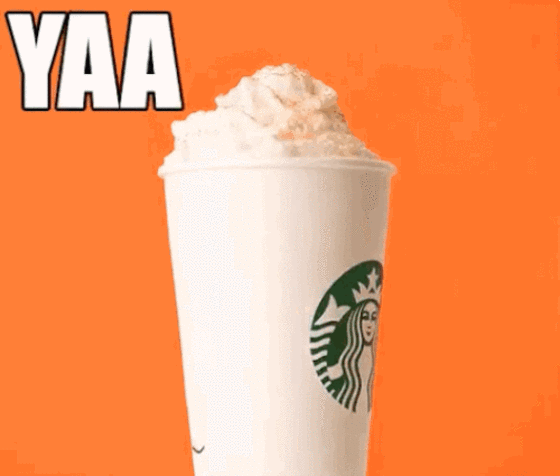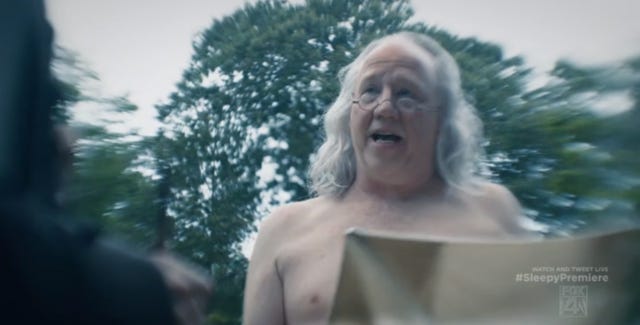So What, Who Cares (vol 1, issue 43) Where the latte is going
Happy Halloween Eve or Halloween, depending on where you live and what time you open this. Are you one of the "average people" who spent at least $77 on Halloween-related paraphernalia this year? What'd you drop the dosh on? Tell me via email or Twitter.
(I think we spent about $45 -- $15 for jack o'lantern pumpkins, $20 for candy, $10 for Halloween-themed stickers for craft projects. The kiddo's costume is home-made this year.)
*
We are watching as lattes flip from signifiers of the elite to signifiers of the downwardly mobile. As the BBC notes, "Food and drink are potent signifiers of lifestyle," and when President Obama saluted someone this summer with a coffee cup in hand, the chattering class was quick to dub the moment the "Latte Salute," an obvious homage to the term "latte liberal." As Politico notes, the alliterative label gained traction because:
The drink became politically charged when it got popular with patrons of American coffee shops, which are common in urban areas, where people are more liberal. It helps that the word is European, even though applying it to describe a beverage made with coffee and milk is an American phenomenon.

The nation's coffee preferences may undergird this stereotype, as the regions in which Starbucks and Dunkin Donuts reign supreme with their fancy drinks are also the country's most reliably liberal regions.
However, the rise of thinkpieces about Basic Bitches -- with their pumpkin spice lattes clamped firmly in the hand that is not holding the smartphone -- points to the cultural devaluation of the latte: instead of being the drink of an urban intelligentsia, the latte is becoming associated with people who are firmly in the middle of the cultural mainstream, if not slightly behind the curve.
So what? Former food journalist and current academic Kyla Wazana Tompkins contends that one of the slickest tricks Starbucks has pulled off is convincing people it's not vending fast food, when that's really what it does. She makes two salient points about the downward drift of the latte:
"It's important to think about the explosion of all of these industrialized lattes, all these frozen lattes, all the Frappuccinos, as links to a larger problem of creating cheap, high-calorie, low-nutrition food for working-class people. ... The more that the latte can be attached to expressing a kind of elite class or race or gendered identity, the more profitable it is, no matter how many billions of them get sold by Tim Hortons or at your local gas station."
Who cares? Possibly only me, because I love watching how product consumption patterns morph over time. Also, since I don't care for lattes, I have no dog in this fight.
*
We sure do love gawping at our rural citizens on television. The details surrounding the recent cancellation of Here Comes Honey Boo-Boo, a TLC reality show about a child beauty pageant contestant and her colorful family, have highlighted the dual phenomena of "redneck TV" and "occasionally, we are uncomfortably reminded that the same people whose lives have been packaged for our entertainment still have to live those lives off-screen."
So what? As Ryan Broderick notes:
The appeal of this new wave of redneck reality TV is more complicated than just middle-class viewers gawking at the poor. There are just as many — if not more — viewers tuning in to see families that actually look like them depicted on television. A lot of people genuinely love Duck Dynasty — it’s a ratings powerhouse and launched a book that sold more than a million copies on Amazon. The show has 8 million Facebook fans. People are not watching Duck Dynasty out of a mean, snarky irony.
Redneck reality TV is significant because it is one of the few places where blue-collar or white rural Americans are represented significantly on the TV dial. It is also one of the few places where we see people in manual labor or rural labor taking well-earned pride in the skills they have; to watch someone on The Deadliest Catch successfully pull in an icy crab trap is to watch someone who respects the process of their work.

It is also significant because the shows reify one particular definition of what it means to be American: Robert Thompson, director of the Bleier Center for Television and Popular Culture at Syracuse University, says of the redneck-TV stars: “These are the people who picked up pitchforks and muskets and fought the Revolution. Our identity came from giving up all those fancy-schmancy European cathedrals and art museums in order to come here to wrestle bears and put up sod huts. This is deep in American mythology.”
There is also a strong economic component: The rise of redneck reality TV is coincident with a protracted period of income inequality. As the U.S. middle class shrinks, there's a rising demand for shows that devise and cement a narrative that life can be good even if you're not possessed of 21st century job skills or the philosophy that we're really just one part of a global village.
Who cares? Redneck TV can be seen as a reflection of the culture wars writ large, and by reinforcing culture war tropes, it manages to sidestep examining the underlying policy decisions and economic conditions of actual, rural America.
Snickering at the libidinous antics of Li'l Bit and Daddy on Party Down South is one thing; it's another to actually pay attention to the regions that are highlighted in these shows -- places where one in five people don't graduate from high school, places where 35% of newborns were exposed to drugs in utero, places that provide little to no workplace protection for new parents. The U.S. has 353 "persistently poor" counties across the nation, where "persistently poor" equals a poverty rate of 20% or more; 300 of those counties are rural.
Redneck reality TV is the closest some viewers are going to get to seeing what poverty in white America is like; for others, it may well be like watching the folks next door.
*

Your pop culture note of the day: You may or may not have seen the trailer for the pending Avengers: Age of Ultron movie, the one where James Spader provides a voice-over narration that reminds women of a certain age why they sat through Pretty In Pink thinking, "Who gives a hoot about Blane? TEAM STEFF."
Well, you have not seen this recut of the Avengers: Age of Ultron Trailer, where Paul Rubens brings his vocal flair to everyone from the Black Widow to Thor. My favorite moment is at the 1:24 mark, when he makes the Hulk giggle. Go watch! It's a two minute mood lifter.
*
Did you miss an issue of So What, Who Cares? The archive is here. Also, there is now a topic index that tells you what was in each issue. If you're like, "I remember there was an issue with a gratuitious picture of The Rock, but when ...?" -- well, now you can find it. (It was September 4, 2014, btw.)
As always, I welcome your feedback and suggestions via email or Twitter. Always let me know what you think about So What, Who Cares? If you really like it, tell a friend to subscribe.

